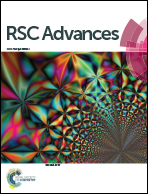Enzymatic manipulation of a DNA-mediated ensemble for sensitive fluorescence detection of glucose†
Abstract
Recently small molecules with fluorescence properties sensitive to DNA have been identified as efficient fluorescent probes. Herein, controllable turn off/on fluorescent sensors for label-free detection of glucose have been successfully developed by designing different DNA/ligand-based ensembles and using the enzyme-catalyzed Fenton reaction. The sensing approach is essentially based on enzymatic manipulation of a DNA-mediated ensemble through cascade reactions, including oxidation of glucose by oxygen to yield hydrogen peroxide, the Fenton reaction of H2O2 resulting in the formation of aggressive hydroxyl radicals (˙OH), and then the oxidative cleavage of ssDNA with ˙OH. Interestingly, the fact that the properties of DNA-mediated ensembles are highly dependent on the nature of ligands opens the opportunity to modulate the response patterns of fluorescent probes to glucose simply by choosing some appropriate ligands. Additionally, the protocol shows excellent selectivity, and visual detection is possible with the aid of an UV transilluminator. Moreover, this method can also be extended as a novel analytical platform for other reactions that involve the H2O2 concentration evolution.


 Please wait while we load your content...
Please wait while we load your content...